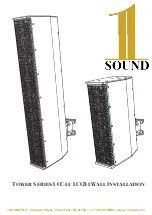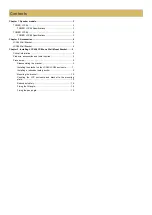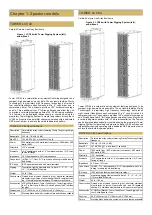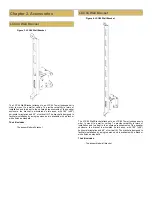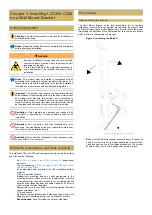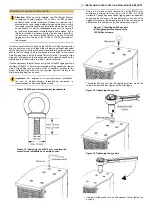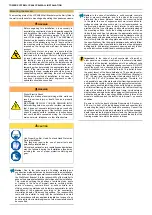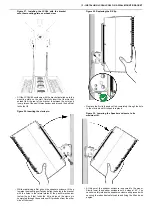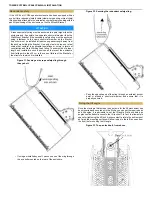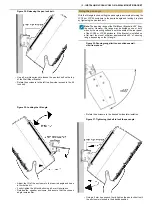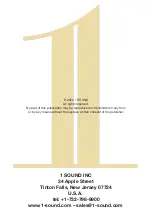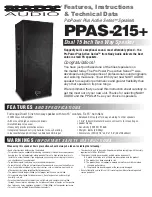
TOWER SYSTEM LCC44/LCC84 WALL INSTALLATION
Mounting the bracket
The mounting plate of the LCC44/84 Wall Bracket must be firmly fitted to
the wall or surface before mounting and pointing the speaker enclosure.
WARNING
Before beginning this installation, it is necessary to
ascertain the construction type, load-bearing capability
and durability of the wall or surface. Bear in mind that
the LCC44 speaker enclosure weighs 10 kg (22 lb)
and LCC84 weighs 19.5 kg (43 lb). The Wall Mount
Bracket is also capable of downward tilt that extends
the mass of the enclosure up to a 40° angle out from
the mounting surface. Therefore, the increased forces
imposed on the fixings and wall must be taken into
account.
Careful thought must be given to ensure that the
wall structure is strong enough to safely support the
total load with the proper Factor of Safety required
by local, state and national norms or legislation. If
the facility or venue is open to the public and the
mount is within reach of the public, the installer should
take into consideration possible miscreant behavior or
tampering when determining the appropriate factor of
safety. If the wall structure is deemed incapable of
supporting the load, consideration should be given to
strengthening and/or stabilizing the wall or adopting
an alternative method of installation. In the case of
any doubt, architects, structural engineers or other
specialists should be consulted.
WARNING
Risk of Electric Shock
Drilling into hidden electrical wiring within walls can
result in serious injury or death, fires and property
damage.
BE AWARE OF WHAT YOU ARE DRILLING INTO.
Before drilling holes in any wall or surface, make sure
that it does not conceal electrical wiring or conduits.
Consult the wiring diagram of the facility or venue and
check for nearby outlets, switches or junction boxes
that could indicate concealed wiring, be it electrical
mains, network, telephone or other infrastructure.
CAUTION
Use Proper Eye, Ear, Head, Foot and Hand Protection
During Installation
This task may require the use of power tools and
potentially elevated loads.
All local and national norms, regulations and guidelines
must be followed during the installation procedures,
including the use of proper protective clothing and
gear.
Notice: Due to the wide variety of building materials and
construction methods that can be encountered in an installation,
1 Sound can only provide general recommendations for installing
the Wall Mount Bracket. It is the responsibility of the installer to
assess the appropriate stability and sturdiness of the installation.
This includes verifying the positions of suitable studs, posts
or framing in the case of drywall mounts, verifying hollow
points in masonry, concrete block or solid concrete, and
utilizing anchoring methods and hardware appropriate for safe
installation of the equipment according to the construction
material and depth of the mounting surface. The responsibility
rests with the installer to verify that the installation is carried
out in accordance with any applicable legislation. In case of any
doubt, architects, structural engineers or other specialists should
be consulted.
Notice: In the case of installation in solid concrete, concrete
block or masonry structures, due to the size of the mounting
plate and the narrow distance between the mounting holes
in the plate, the use of expansion anchors (sleeve anchors,
wedge anchors, plastic anchors etc.) is not recommended, as
the proximity between them is likely inferior to safe spacing
practices for this type of fastener, and could potentially weaken
the mounting surface. Verify the building material, as well as
its depth and condition to determine the appropriate anchoring
system. Make sure that the fasteners include washers or have
flanged heads with adequate outer diameter (from 14 mm to 16
mm) to firmly hold the mounting plate around the holes. Consult
the specifications of the third-party hardware and carefully follow
the instructions of the manufacturer to determine the appropriate
drilling depth, bit diameter, necessary spacing and any further
specific instructions or additional necessary procedures.
Important: In the case of a wall constructed of drywall or
other panels on a wooden stud frame, it is extremely important
to verify that the desired installation point has sufficient solid
backing to support the installed speaker enclosure. DO NOT
install the mount on unbacked drywall, plywood or plastered
lath. A studfinder can be useful for this, but it is better to know
the exact layout of the frame beforehand. The center-to-center
width between the mounting holes of the Wall Mount Bracket is
1.89" (48 mm), and therefore wider than standard 2x4 (1.5" x
3.5") or 2x6 (1.5" x 3.5") wooden framing studs. Therefore, it is
only possible to mount the plate onto other framing members with
doubled or wider widths, such as doubled posts or column studs,
corner posts, doubled jamb/king studs, solid lintels, or purpose-
built internal framing. Be careful to assure that all four mounting
holes will be drilled into the solid wood frame. Joints between
single studs and single horizontal noggings or fireblocks could be
deceptive and provide a mounting position with only three of the
screws in solid wood and the fourth only in drywall – an unsafe
condition.
Be sure to verify the depth of drywall (commonly 0.5 inches or
6.35 mm) in front of the load-bearing studs and consider this
in selecting the length of the fastener necessary. Consult the
specifications of the third-party hardware to verify the necessary
depth to guarantee the required safety factor, but remember that
it is unwise and potentially hazardous to exceed the depth of the
framing member into which the anchor is driven.

